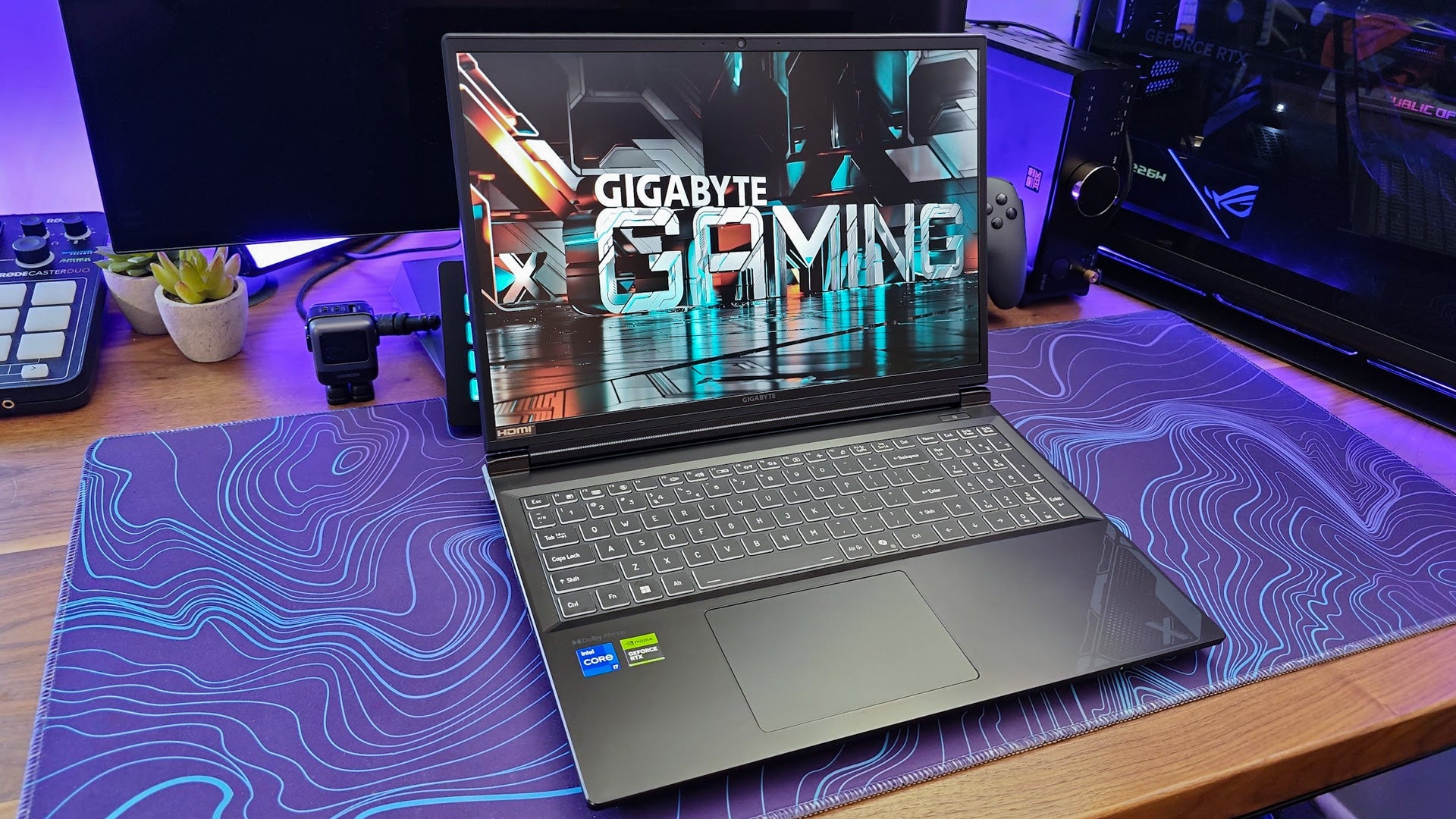When Gigabyte first broke into the world of gaming monitors, there were honest questions about whether it would be able to pull it off. It’s not every day a component maker breaks into such a different category, let alone one already dominated by some of its biggest competitors. It’s been five years since that launch, and in that time the company has established itself as one of the brands gamers should be considering, all the way from affordable displays to the high-end and cutting-edge.
The Gigabyte FO32U2 Pro is the company’s new flagship and is easily one of the best OLED gaming monitors you can buy today. Coming in at $1,299 for the model we’re reviewing and $1,099 for the version without DisplayPort 2.1, it isn’t cheap, but it’s also fantastic in just about every way. Whether you’re purely gaming or mixing up your matches with work and the web, it offers big improvements over last generation and a picture that can, at times, be mesmerizing. This is one of the best monitors I’ve ever used and is well worth saving up for.
Gigabyte FO32U2 Pro – Design and Features
The Gigabyte FO32U2 Pro uses Samsung’s latest QD-OLED panel, which addresses many of the issues plaguing prior generations. It comes in an immersive 32-inch size and runs at a full 4K, 240Hz resolution with a peak brightness that exceeds 1,000 nits in sustained highlights. If that weren’t enough, it also comes with a suite of OLED Care features to reduce the risk of screen burn-in and a 3-year warranty just in case the worst should happen.
Unboxing it for the first time, you get all of the expected cables for DisplayPort, HDMI, USB, and power. The power supply isn’t integrated, which helps with the slimness of the panel, but the subsequent power brick is large and in charge, making cable management more of a chore.
You also have the stand, which is just about on par with other premium gaming monitors. It’s heavy but not unwieldy and uses two angled feet for stability instead of a pedestal. You’ll lose a bit of desk space in comparison but nothing major. It offers five inches of height adjustment, 20 degrees of swivel, and -5 to +20 degrees of tilt. You can also rotate the display into portrait mode in a two-monitor setup. The stand comes in two pieces that connect with a thumbscrew, and the whole thing latches onto the back of the monitor, no tools required. It also supports standard VESA mounting if you’d prefer to use an arm.

If you’ve never looked closely at an OLED panel, you might be surprised at how thin it is. There’s a box on the back that houses the internals, but most of the display is millimeters thin. It can be a little unnerving to assemble and adjust but it’s backed by a sturdy frame, so there’s no flex to concern yourself with.
The whole thing looks very premium. There’s nothing overly aggressive that screams “gaming” from the front – there’s frankly no room for it with the monitor’s vanishingly thin bezels. You’ll find a touch of RGB on the back with an animated panel on the top of the processing box and some Aorus staple angles on the rear frame but it’s surprisingly tame.
The picture on the FO32U2 Pro is amazing. Because it can individually dim all of its eight million pixels, it’s able to offer infinite contrast for rich, deep blacks. This particular model, as well as its counterparts at Asus and MSI that use the same panel, has been enhanced with a layer of quantum dots. These nanoparticles work to enhance its brightness and the vibrancy of its colors. It makes for a substantial improvement in picture quality but at the cost of contrast if a light is shined directly on the screen, which creates purplish raised blacks.
It offers very similar specs to the Asus PG32UCDM we reviewed in February: 1,000 nits of peak HDR brightness and 99% coverage of the DCI-P3 color spectrum. Its contrast ratio is technically 1.5M:1, though it may as well be considered infinite at that point. It supports variable refresh rate with AMD FreeSync Premium Pro certification and is compatible with Nvidia G-Sync without any stutters or quirks. It’s also VESA TrueBlack 400 certified, which appears to be leveraged in three of its five HDR modes, while the remaining three push the brightness above 1,000 nits sustained in a 2% window.

The monitor comes in two different versions: the Pro model we tested and the standard FO32U2 for $200 less. The price difference is due to the Pro model’s DisplayPort 2.1 port, which is a still-rare and very forward-thinking feature. While most monitors only support DisplayPort 1.4 (which this does as well), DP 2.1 unlocks the full 80 Gbps bandwidth of the connection, removing the need for Display Stream Compression (DSC).
This has a couple of benefits and one big caveat. The higher bandwidth allows you to daisy chain multiple monitors together without running a second cable back to your graphics card. You’ll also be able to take advantage of Nvidia’s Dynamic Super Resolution (DSR) to achieve an even more crisp image. The drawback is that you can’t do any of this yet. Neither AMD or Nvidia currently offer graphics cards with DP 2.1 support, though it’s widely expected that this will arrive with the next generation from each manufacturer.
OLED monitors have come a long way since they first hit the market, but burn-in is still a concern. Thankfully, the FO32U2’s suite of OLED Care protections and the 3-year warranty make this less of a concern than it has been in the past. The protections include pixel cleaning on a four-hour timer, pixel shifting, logo detection, static image detection, corner dimming, and average picture level (APL) stabilization. Of these, only the pixel shifting and APL are noticeable for normal use.
The implementation of APL versus the automatic backlight limiter (ABL) on the FO48U is much better. Like many OLED monitors released around the same time, its ABL would dramatically dim the screen based on how much white it detected. Instead, it strives to keep an average balance, so brightness changes are less noticeable and distracting.
The FO32U2 Pro is packed with gaming features. The staples exist inside the OSD, but there are also several new and interesting features. There’s a built-in KVM, so you can switch your peripherals to a console or second PC without needing to swap cables. Gigabyte has also added a new tactical button next to the OSD joystick which can be mapped to a setting of your choice, but by default puts the monitor into 1080p mode. Instead of stretching the image across its full 32 inches, it crops in and gives you a smaller picture on the larger screen to preserve image quality. This is perfect for games where the responsiveness of a 240Hz frame rate is your goal but isn’t possible at 4K resolution.

Inside the OSD, you’ll find its returning gaming features. Classics like PiP/PbP and Black Equalizer are back, which allows you to better pick out enemies in shadowy environments and monitor a second video source while you play. You can set an on-screen reticle, add a timer overlay to your screen, or a system hardware monitor to keep an eye on your speeds, temps, and frames per second even in games that would usually block overlays.

A couple of newer features are included, too. Eagle Eye magnifies the center of your screen to make scoring distant headshots easier. Gigabyte says there’s a Night Vision mode that highlights contrast in bright green but I wasn’t able to find it anywhere, so maybe it’s planned for a future update. It also has built-in speakers, which get plenty loud but are pretty thin sounding. Instead, we recommend plugging in a headset to its included audio port as the monitor comes with a high-end ESS DAC for impressively clear and detailed audio through headphones.

Returning to the OSD, there are plenty of options outside of its gaming features. A wide array of picture presets are present encompassing different genres, common uses, and sRGB. There is a wider amount of HDR modes than we typically see too: HDR, HDR Movie, HDR HLG, HDR Game, and HDR Vivid. Impressively, only the standard HDR and HLG modes lock down the settings. The others allow you to tweak settings to your liking, which isn’t very common.

Within most of the SDR presets, you’re given an even wider array of options to customize the picture. In fact, there’s a full six-axis color mixer, as well as color temperature and gamma settings, in addition to staples like Brightness, Contrast, Saturation, and Sharpening. There’s a large amount of calibration potential here, should you find there’s a need or your tastes differ from how it comes from the factory.

Most of these settings are available with Gigabyte’s Control Center Software, so you don’t need to spend time in an OSD. While convenient, it’s missing some gaming features, like Black Equalizer. It also removes any ability to assign hotkeys, which is a major loss for the usability of features like Black Equalizer and the Eagle Eye mode. Though you can tie custom functions to all four directions of its joystick and its tactical switch, no one wants to be reaching around under their monitor in the middle of a match.
The software honestly feels like a step back from the simple and small OSD Sidekick Gigabyte used to use. Now, you’re forced to install a whole suite of different modules that you may not even need. Bringing all of its components under one suite makes sense, unless you’re looking for something small and lightweight, or just want to adjust your monitor without clicking the OSD. Then, it just becomes a bit much.
The monitor comes well-calibrated out of the box. On the spec sheet, Gigabyte rates it with an average Delta < 2. In our tests, even this was conservative and it was even closer than that. You could easily use this straight out of the box for creative work. Creative professionals will still want to apply their own calibration for the best results but the FO32U2 Pro is impressively accurate.

Finally, for I/O, we have two HDMI 2.1 ports, one DP 2.1 and one DP 1.4, a mini DP 2.1, and a USB Type-C port that can be set to an alternate mode for data or power delivery up to 65 watts to keep your laptop charged. There’s also a built-in USB hub with two USB 3.2 Type-A ports and a USB Type-B for connecting to your computer, as well as a headphone and microphone jack.
Gigabyte FO32U2 Pro – Performance
The Gigabyte FO32U2 Pro is an absolute performer. Its picture quality is outstanding. The layer of quantum dots immediately enhances its presentation compared to prior-gen OLEDs that lacked them. The screen pops with more brightness and color, even outside of HDR, and the effect is bolstered by its more nuanced brightness management system.

Colors are exceptionally vivid, which makes any kind of entertainment, whether in SDR or HDR, more engaging. Its factory calibration is also close. I measured it at an average of less than Delta < 1 even though it’s rated for Delta < 2. You can put the monitor into sRGB mode to better simulate that space if you don’t have a colorimeter, but the best results can be had by running that extra calibration run at home.
The magic of OLED is its pixel-by-pixel brightness control. Its incredible contrast scales from the deepest blacks to eye-searing 1,000+-nit highlights. The dynamic range is wide, which makes HDR content look vivacious, virtually popping off the screen. The Lower City of Baldur’s Gate 3 never looked so good. You’ll need to be in HDR to achieve the highest brightness, but even SDR content looks good on this monitor.

There is a big difference between its different HDR modes. To achieve its peak brightness of 1,000 nits, you’ll need to be in the HDR Vivid or HDR Game modes. Each hit around 1,080 nits in our testing. Standard HDR mode, HDR Movie, and HDR HLG modes each landed between 472 and 484 nits. Several of these modes don’t allow you to change settings, like the standard HDR mode and HDR HLG, as they both attempt to maintain industry standards. HDR Vivid and HDR Game, on the other hand, are based on your preference and do allow picture customizations.

The response time is expectedly fantastic. OLEDs are inherently much faster than LCD gaming monitors, which already makes ghosting less visible. The high pixel density and rapid 240Hz refresh rate decrease it further. We photographed a run-through of BlurBuster’s Test UFO Ghosting Test and found no ghosting whatsoever.
In-game performance is just as clear and fluid. The mix of high refresh rate and low response time makes shooters like Valorant feel especially responsive. This is enhanced further if you enable Nvidia Reflex, but isn’t necessary to both see and feel its improved fluidity. We noticed this on the Asus PG32UCDM too: compared to jumping from 144Hz to 240Hz on an LCD panel, the upgrade is more noticeable even outside of gaming, moving the mouse.

The reality is that, even with an RTX 4090, most games won’t actually run at 240 FPS outside of esports. But don’t let that dissuade you. The refresh rate and response time of the monitor still make games feel more responsive. This improves alongside your in-game frame rate, so there’s reason to try to improve performance. The higher your frame rate, the increased motion clarity, too. But you still benefit, even without hitting its maximum play rate.
If you keep a console at your desk, the KVM is also very useful. Being able to swap your keyboard and mouse or controller to another console with a single button press eases the switching process. It’s not quite as seamless as the Logitech Astro A50 X’s switch button, but it’s much faster than switching things over manually.
This generation has also brought major improvements to productivity. Text clarity has been a major issue facing OLED monitors, but that’s a thing of the past with this display. Like its competitors, the FO32U2 uses an improved sub-pixel array that is much more effective at preventing haloing/fringing around text. That, in combination with its higher pixel density, makes text comparable to a LCD monitor at typical viewing distances. Technically, it’s still there if you scale Windows to a ridiculous degree, but since almost no one does that, this last-gen Achilles heel appears dead.

Its OLED Care features are more extensive and much better implemented than many first- and even second-generation OLED gaming monitors. The new APL Stabilize setting dramatically reduces the amount of visible brightness reduction when opening white or light-colored content on the screen. For example, on the Gigabyte FO48U, opening a fullscreen Google Doc would instantly drop the brightness by what felt like half or more. Shrinking that window would scale up brightness the smaller it got. You had to trade window size for brightness.
Here, the APL Stabilizer balances screen brightness across the whole panel and sets a cap on its maximum nits across three levels: Low (250 nits), Medium (450 nits), and High (1,000 nits). The default setting is Low and honestly doesn’t give a great first impression: you turn on your expensive, HDR flagship gaming monitor and the screen lacks pop. The picture presets and adjustments fix this. You can change modes at any time, and HDR defaults to High which shines brightly even without bright highlights on screen. Most importantly, it prevents this kind of dramatic dimming. There is a reduction but it's much smaller and we didn’t even notice it most of the time.
Another issue that plagued older OLEDs for productivity is that they would dim themselves any time they detected a static screen (a burn-in protection), but weren’t always the best detecting small amounts of motion, like a moving cursor in a document or spreadsheet. The FO32U2 Pro has the same protection but is much better at maintaining brightness during productivity tasks.
Gigabyte also seems to have fixed the Pixel Clean bug that impacted some models of its FO48U. The bug would cause the display to inaccurately track the amount of hours it had been used, causing pixel cleaning to begin inconsistently. That isn’t the case at all here. The monitor alerts you when it has accumulated four hours of use and gives you the option to run the cleaning cycle immediately or on a delay. Our sample had an issue where this cycle would not run when the monitor went into standby and only when manually engaged, an issue other users have also reported. Hopefully will be addressed in a firmware update.






